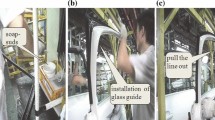Abstract
In a multi-plant collaborative manufacturing system, the manufacturing operations and assembly operations for producing a product can be distributed at different plants at various locations. The components are assembled with assembly operations performed in a multi-plant assembly sequence. In this research, a multi-plant assembly sequence planning model is presented by integrating (1) assembly sequence planning, and (2) plant assignment. In assembly sequence planning, the components and assembly operations are sequenced according to the assembly constraints and assembly cost objectives. In plant assignment, the components and assembly operations are assigned to the suitable plants to achieve multi-plant cost objectives. The feasible assembly sequences are generated using the developed graph-based models of assembly precedence graphs and matrices. A genetic algorithm (GA) method is presented to evaluate the multi-plant assembly sequences with an objective of minimizing the total of assembly operational costs and multi-plant costs. The main contribution lies in the new model for multi-plant assembly sequence planning and the new GA encoding scheme for simultaneous assembly sequence planning and plant assignment. Example products are tested and discussed. The test results show that the presented method is feasible and efficient for solving the multi-plant assembly sequence planning problem.
Similar content being viewed by others
References
De Fazio TL, Whitney DE (1987) Simplified generation of all mechanical assembly sequences. IEEE J Robot Autom RA-3(6):640–658
Homem de Mello LS, Sanderson AC (1990) AND/OR graph representation of assembly plans. IEEE Trans Robot Autom 6(2):188–199
Homem de Mello LS, Sanderson AC (1991) Representation of mechanical assembly sequences. IEEE Trans Robot Autom 7(5):211–227
Santochi M, Dini G (1992) Computer-aided planning of assembly operations: the selection of assembly sequences. Robot Comput-Integr Manuf 9(6):439–446
Lin AC, Chang TC (1993) An integrated approach to automated assembly planning for three-dimensional mechanical products. Int J Prod Res 31(5):1201–1227
Lin AC, Chang TC (1993) 3D MAPS: three dimensional mechanical assembly planning systems. J Manuf Syst 12(6):437–456
Laperriere L, ElMaraghy HA (1996) GAPP: a generative assembly process planner. J Manuf Syst 15(4):282–293
Gottipolu RB, Ghosh K (1997) Representation and selection of assembly sequences in computer-aided assembly process planning. Int J Prod Res 35(12):3447–3465
Zhao J, Masood S (1999) An intelligent computer-aided assembly process planning system. Int J Adv Manuf Tech 15:332–337
Abdullah TA, Popplewell K, Page CJ (2003) A review of the support tools for the process of assembly method selection and assembly planning. Int J Prod Res 41(11):2391–2410
Chen RS, Lu K-Y, Tai PH (2004) Optimizing assembly planning through a three-stage integrated approach. Int J Prod Econ 88:243–256
Chen RS, Lu K-Y, Yu S-C (2002) A hybrid genetic algorithm approach on multi-objective of assembly planning problem. Eng Appl Artif Intell 15:447–457
Lai H-Y, Huang C-T (2004) A systematic approach for automatic assembly sequence plan generation. Int J Adv Manuf Tech 24:752–763
Wang JF, Liu JH, Zhong YF (2005) A novel ant colony algorithm for assembly sequence planning. Int J Adv Manuf Tech 25:1137–1143
Bai YW, Chen ZN, Bin HZ, Hun J (2005) An effective integration approach toward assembly sequence planning and evaluation. Int J Adv Manuf Tech 27:96–105
Zhou X, Du P (2008) A model-based approach to assembly sequence planning. Int J Adv Manuf Tech 39:983–994
Su Q (2007) Computer aided geometric feasible assembly sequence planning and optimizing. Int J Adv Manuf Tech 33:48–57
Dong T, Tong R, Zhang L, Dong J (2007) A knowledge-based approach to assembly sequence planning. Int J Adv Manuf Tech 32:1232–1244
Tseng Y-J, Jhang J-F, Huang F-Y (2007) Multi-plant assembly panning models for a collaborative manufacturing environment. Int J Prod Res 45(15):3333–3349
Wang L, Keshavarzmanesh S, Feng HY, Buchal RO (2009) Assembly process planning and its future in collaborative manufacturing—a review. Int J Adv Manuf Tech 41:132–144
Wang Y, Liu JH, Li LS (2009) Assembly sequence merging based on assembly unit partitioning. Int J Adv Manuf Technol, published online: doi:10.1007/s00170-009-1993-z
Choi YK, Lee DM, Cho YB (2009) An approach to multi-criteria assembly sequence planning using genetic algorithms. Int J Adv Manuf Tech 42:180–188
De Lit P, Latinne P, Rekiek B, Delchambre A (2001) Assembly planning with an ordering generic algorithm. Int J Prod Res 39(16):3623–3640
Marian RM, Luong LHS, Abhary K (2003) Assembly sequence planning and optimization using genetic algorithms. Appl Soft Comput 2/3F:223–253
Li JR, Khoo LP, Tor SB (2003) A tabu-enhanced genetic algorithm approach for assembly process planning. J Intell Manuf 14(2):197–208
S-F SS (2004) Using multiple genetic operators to reduce premature convergence in genetic assembly planning. Comput Ind 54:35–49
Kongar E, Gupta SM (2006) Disassembly sequencing using genetic algorithm. Int J Adv Manuf Tech 30:497–506
Tseng Y-J, Lin C-H, Lin Y-H (2008) Integrated assembly and machining planning for electronic products using a genetic algorithm approach. Int J Adv Manuf Tech 30:140–155
Su Q (2007) Applying case-based reasoning in assembly sequence planning. Int J Prod Res 45(1):29–47
Goldberg DE (1989) Genetic algorithms in search, optimization, and machine learning. Addison-Wesley, Reading, MA
Author information
Authors and Affiliations
Corresponding author
Rights and permissions
About this article
Cite this article
Tseng, YJ., Chen, JY. & Huang, FY. A multi-plant assembly sequence planning model with integrated assembly sequence planning and plant assignment using GA. Int J Adv Manuf Technol 48, 333–345 (2010). https://doi.org/10.1007/s00170-009-2264-8
Received:
Accepted:
Published:
Issue Date:
DOI: https://doi.org/10.1007/s00170-009-2264-8




